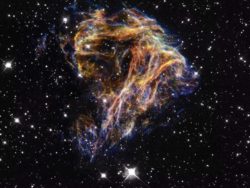Astronomy Picture of the Week – Distant Nebula
This nebula, designated as N 49 or DEM L 190, looks like puffs of smoke or sparks from a fireworks display. It is one of the most distant nebulae ever observed, located in the Large Magellanic Cloud, a dwarf galaxy orbiting the Milky Way. The nebula is the result of a large supernova, whose light should have reached Earth a few thousand years ago.

